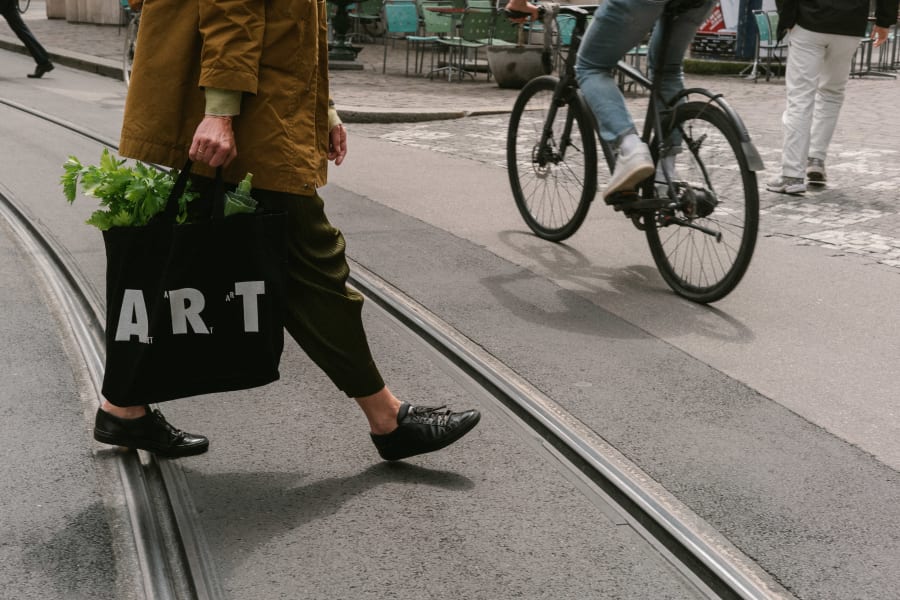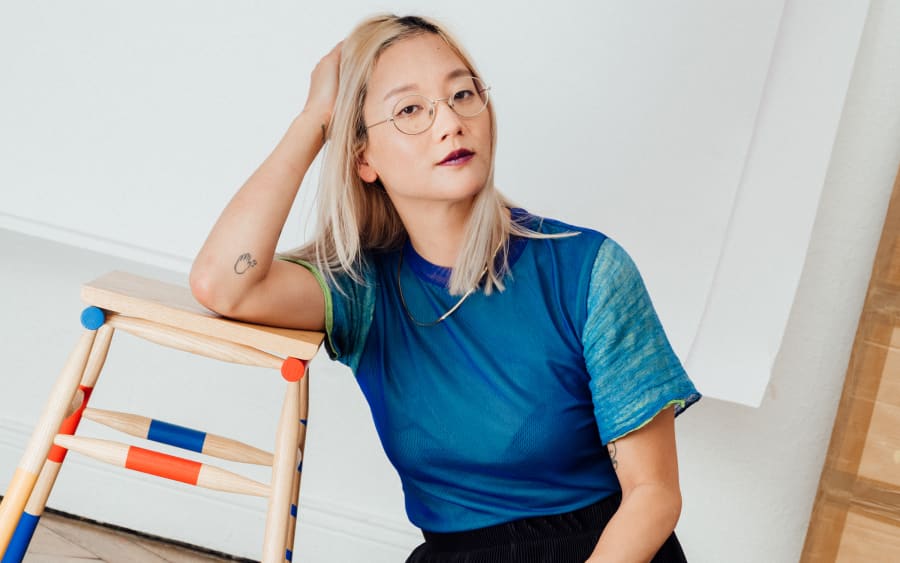Car horns, intercom announcements, and spoken languages: Society is built for the hearing, but artist Christine Sun Kim works to recalibrate our understanding of such sound-based experiences. Known for her charcoal drawings, large-scale painted murals, and videos, Kim made waves with her performances of the national anthem and ‘America the Beautiful’ in American Sign Language at the Super Bowl in 2020. Now, she has turned her hand to a collaboration with retail legend Sarah Andelman, designing a series of objects for the inaugural Art Basel Shop.
‘This is the largest editioned project I’ve done to date,’ Kim says during an interview conducted with the assistance of an ASL interpreter. ‘It’s crazy to see how my work has been able to transfer from one medium to another.’
Kim’s capsule collection for the shop includes three porcelain plates, a pocket mirror, two sweatshirts, a T-shirt, a silk scarf, a baby rattle, a jigsaw puzzle, a rubber stamp, and postcards. Andelman suggested different objects, and Kim decided which to pursue. Once the base products were selected, the artist dove into her archive and carefully chose drawings and installations to rework according to each object’s specific format and function. ‘When I look at the objects, I look at them like I would at a canvas or piece of paper,’ Kim explains. Ultimately, she selected objects that she had never previously worked with and that appealed to her personally. ‘I’m the most excited about the plates,’ she says, ‘and that’s probably because I just moved into a new home, and I want a new set of plates.’
The three porcelain plates, manufactured by Non Sans Raison, reproduce slightly altered versions of Kim’s works See Zero (2019), Clock Face (2020), and Trauma, LOL (2020). See Zero is a triptych of charcoal drawings, each featuring an off-kilter circle, charcoal smears, and the phrase ‘see zero.’ The phrase is an example of ‘Deaf English,’ meaning something that is translated literally from ASL into written English. ‘If somebody tells me some gossip or about a problem and I reply, “see zero,” it means, “I don’t know about that” or “that’s not true,”’ Kim explains. ‘Or, if people are stuck on something and I want them to move on, I say “see zero” – there’s nothing to see here, keep it moving.’ On the plate, the charcoal smears appear only outside the roughly drawn circle; inside, there’s nothing to see.
Deaf English phrases recur throughout Kim’s work. An editioned rubber eraser she made for Printed Matter’s NY Art Book Fair in 2019 featured the phrase ‘sorry zero’ on one side, and the English idiom ‘sorry not sorry’ on the other. Her series ‘English vs Deaf English’ (2018) offers succinct one-to-one translation tables. In one drawing, the left column includes English phrases or commonly used words: ‘Whatcha doing,’ ‘Not gonna repeat myself,’ and ‘iMessage.’ On the right side are the Deaf English equivalents: ‘Do do,’ ‘Train gone sorry,’ and ‘FT’ (FaceTime). At Art Basel in Basel, these works, among others, will be available as postcards.
A public figure and advocate for the Deaf community, Kim’s personal life often bleeds into her practice. When she and her hearing partner had their first child, who is also hearing, she created a ‘sound diet’ in the home to establish a balance between signed and spoken languages, and to prioritize non-sonic stimuli. This concept inspired a series of drawings in which Kim suggests different amounts of sounds – from Netflix, music, spoken languages, or toys – for the home, like a nutritionist planning a diet. Given this domestic arrangement, making an editioned baby rattle seems like a conspicuous choice. In response, Kim says, ‘any first-time parent will understand the desire to be perfect, and the inflexibility you feel like you need to have,’ but with her second child now 8 months old, she explains that she has ‘become a little more flexible.’ This means that sound toys, which can create an imbalance between a Deaf parent and hearing child, are still limited in her home, but she has loosened up; as long as the toy does not emit specific words or notes, she will allow it. Fittingly, the phrase she chose to engrave on the rattle is ‘the sound of being loose.’
Other standalone phrases on the editioned items include ‘listen hear’ on a rubber stamp and ‘make me sound smart’ embroidered on a green sweatshirt. The latter refers to Kim’s experience with interpreters, who often voice her during important meetings, talks, or interviews. Ahead of an event, she tells interpreters the tone she wants to convey: Sometimes she asks them to make her sound angry; other times, when she is actually too angry, she asks them to tone it down. And yes, in some situations, she even asks them to make her sound smarter. ‘I really like how some interpreters can make me sound funnier or smarter than I actually am,’ she says with a laugh. While Deaf experiences are at the center of Kim’s practice, her use of humor is what makes her work accessible to a wider audience – an audience that will continue to grow as her editions are taken home, used, and worn on streets around the world.
Christine Sun Kim is represented by François Ghebaly (Los Angeles, New York) and White Space (Beijing).
On June 11, the Art Basel Shop will have a meet-and-greet with Kim from 2.30-3.30 pm where attendees can acquire signed editions of her work. She will also show a new large-scale mural presented by White Space in the Unlimited sector.
This conversation was interpreted by Beth Staehle.
Emily McDermott is a writer and editor living in Berlin.
Caption for top-image: Christine Sun Kim x Art Basel, Presentation plate, The Art Basel Shop.
Published on June 10, 2024.


